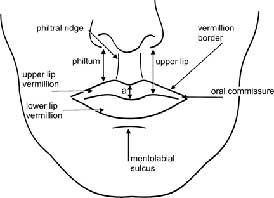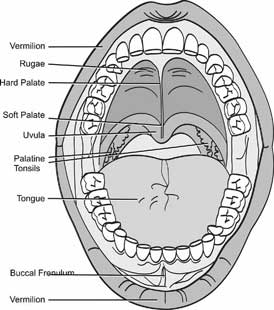Anatomy of the Lips, Mouth, and Oral Region
The appearance of the lips varies with facial movement. Smiling and crying can alter dramatically the shape of the upper lip, as do pursing or pouting. Therefore, the lips must be assessed when the subject has a relaxed (neutral) face: the eyes are open, the lips make gentle contact, and the teeth are slightly separated. The neck, jaw, and facial muscles should not be stretched nor contracted, and the face should be positioned using the Frankfurt horizontal (a line joining the orbitale and the porion) [Farkas, [1981]].

Figure 1

Figure 2
- Lips:
- The structures that surround the oral aperture (Fig. 1). In the central region their superior border corresponds to the inferior margin of the base of the nose. Laterally, their limits follow the alar sulci and the upper and lower lips join at the oral commissures. The inferior limit of the lips in the central region is the mentolabial sulcus. Anatomically, the philtrum and its pillars are a part of the upper lip. The surface of the lip is comprised of four zones: hairy skin, vermilion border, vermilion and oral mucosa. The normal shape of the lips varies with age, and is influenced by ethnicity.
- Vermilion:
- The red part of the lips (Fig. 1). It is covered with a specialized stratified squamous epithelium, which is in continuity with the oral mucosa of the gingivolabial groove. Confusingly, the vermilion itself is also often referred to as the lips.
- Vermilion Border:
- The rim of paler skin that demarcates the vermilion from the surrounding skin.
- Cupid's Bow:
- The contour of the line formed by the vermilion border of the upper lip. In a frontal view, this line resembles an archer's bow, which curves medially and superiorly from the commissures to the paramedian peaks located at the bases of the pillars of the philtrum (crista philtrae) with an inferior convexity lying between those peaks. The philtrum is the vertical groove in the midline of the upper lip bordered by these lateral pillars (ridges) [Hennekam et al., [2009]].
- Oral Mucosa:
- Stratified squamous non-keratinized epithelium covering of the inner aspect of the oral cavity [Standing, [2005]].
- Mouth:
- The oral aperture that opens into the oral cavity proper [Standing, [2005]]. The opening is bounded by the upper and lower vermilion. The cavity comprises the alveolar arches with gums and teeth, the hard and soft palate, and the tongue, anchored to the floor of the mouth (Fig. 2). The oral cavity leads into the oropharynx, bounded by the tonsillar pillars. Standards exist for measuring the length and height of the oral aperture [Farkas, [1981]].
- Oral Commissure:
- The place where the lateral aspects of the vermilion of the upper and lower lips join. The cheilion is the anthropological landmark located at this site (see Fig. 1).
- Labial Fissure:
- Slit-like space between the lips; the oral vestibule.
- Oral Cavity:
- The space bounded superiorly by the hard and soft palates, laterally by the alveolar processes of the maxillary bone, and inferiorly by the tongue (see Fig. 2).
- Alveolar Ridge:
- The U-shaped bony crests of the upper and lower jaw in which the teeth are situated.
- Hard Palate:
- Bony anterior two-thirds of the roof of the mouth separating the nasal cavity from the oral cavity. The boundary of the hard and soft palates can be determined by palpation.
- Soft Palate (velum palatinum):
- Posterior one third of the palate comprised of a fibromuscular fold of soft tissue suspended from the hard palate and separating the nasal and oral cavities.
- Uvula:
- A conical projection of soft tissue extending inferiorly from the posterior edge of the middle of the soft palate (see Fig. 2).
- Gingiva (gums):
- Dense fibrous tissue covered by mucous membrane overlying the alveolar ridge in which the teeth are situated.
- Buccal Frenulum:
- A thin fold of soft tissue extending from the gingiva of the mid-anterior alveolar ridge to the inner surface of the medial part of the upper or lower lip (see Fig. 2).
- Lingual Frenulum:
- A thin fold of soft tissue extending from the floor of the mouth to the base of the tongue.
- Tongue:
- Muscular organ of deglutition, speech and taste covered with epithelium and bound to the floor of the mouth.
- Teeth:
- Hard dental structures located on the alveolar ridges and situated in the gingiva. In humans, teeth have two stages, the primary (deciduous) and the secondary (permanent, adult).










